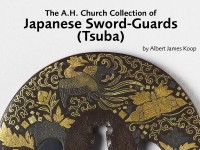The A. H. Church Collection of Japanese Sword-Guards (Tsuba)
An unpublished catalogue of the A. H. Church collection of Japanese sword-guards (tsuba) by Albert James Koop.

At Mito in Hitachi province, the seat of the most powerful cadet branch of the Shōgunal family (Tokugawa), were settled four important groups of sword-furniture makers, including (besides the present one) the Sekijōken, the Ichiriū, and the Yegawa. These practised styles of varying character, through which there runs, nevertheless, a certain vein of similarity.
Kikuchi (or Gunji) Kōami was a pupil of the Gotō; his work is rare. His famous pupil Yatabe Tsūju (d. 1768) studied also under Nara Toshinaga, whose style he largely followed. Tsūju’s pupil Tamagawa [Japanese text] Yoshinaga was succeeded by his son of the same name (differently written in Chinese characters) and his famous nephew Yoshihisa I; the surname Nukagawa [Japanese text] was borne by several other pupils of this family.
Uchikoshi Kōju was a pupil of the second Tamagawa. He and his followers pursued a style characterised by much delicacy and great elaboration of detail. Representations of caverns and rocky ground often appear in their designs.
 Tsuba depicting a Chinese emperor, his attacker, and a dragon (EAX.11001)
Tsuba depicting a Chinese emperor, his attacker, and a dragon (EAX.11001)
 Tsuba with decaying aoi, or hollyhock leaf (EAX.11002)
Tsuba with decaying aoi, or hollyhock leaf (EAX.11002)
 Tsuba depicting a Chinese fisherman on a river bank (EAX.11003)
Tsuba depicting a Chinese fisherman on a river bank (EAX.11003)
Notice
Object information may not accurately reflect the actual contents of the original publication, since our online objects contain current information held in our collections database. Click on 'buy this publication' to purchase printed versions of our online publications, where available, or contact the Jameel Study Centre to arrange access to books on our collections that are now out of print.
© 2013 University of Oxford - Ashmolean Museum





